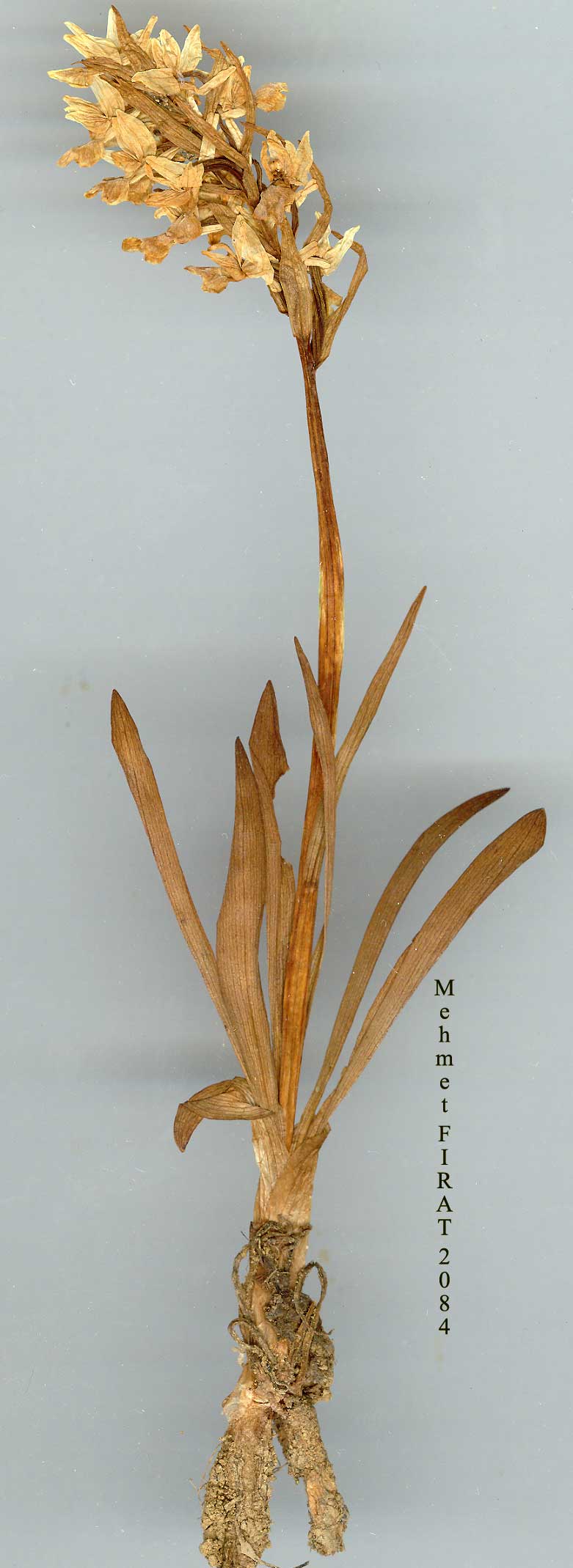| Orchidaceae |
|---|
 SOO subsp_ georgica (KLINGE) SOO EX RENZ_ ET TAUB_jpg.jpg)
Dactylorhiza romana (SEB.) SOO subsp. georgica (KLINGE) SOO EX RENZ. ET TAUB |
 Dactylorhiza romana (SEB.) SOO subsp. georgica (KLINGE) SOO EX RENZ. ET TAUB |
Dactylorhiza NECKER EX NEVSKI |
D. romana (Seb.) Soó, Nom. Nov. Gen. Dactylorhiza, Budapest 3 (1962). Plants 15-40 cm. Base of stem with 2-3 large brownish sheaths, enclosing the numerous linear to lanceolate leaves. Spike shortly cylindrical. Bracts herbaceous, exceeding the violet-purple, dull red or yellow (sometimes whitish) flowers. Sepals oblong, to 13x5 mm; lateral sepals ireflexed. Petals obliquely ovate, 10 x 4-7 mm. Labellum i stretched forwards, ovate to broadly ovate, to 15 mm broad, shortly 3-lobed in front, sometimes entire, without dots or lines. Spur 10-25 mm. 1. Flowers red to yellow, rather large; labellum usually broader than long, to 15 mm broad; spur cylindrical, longer than ovary, (13-)17-20(-25) mm, curved ± steeply upwards subsp. romana 1. Flowers mainly yellow, rather small; labellum usually longer than broad, to 8 mm broad; spur narrowly cylindrical, equalling or shorter than ovary, (8-)10-12 mm, ± straight, directed horizontally or slightly upwards subsp. georgica subsp. romana. Syn: Orchis romana Seb., Rom. PL l:12(1813);Seb. &Mauri, Fl. Rom. Prodr. 308 (1818); O. pseudosambucina Ten.,Syn. Neap. 72(1815); Dactylorhiza sulphurea (link) Franco subsp. pseudosambucina (Ten.) Franco in Bot. J. Linn. Soc. 76:366(1978) comb. inval.D. sambucina (L.)Soó subsp. pseudosambucina (Ten.) Sunderm., Europ. Medit. Orchid, ed. 3:40(1980). Ic: Daneseh, Orch. Eur., Südeur. 202, 203 (1969); Nieschalk, op. cit. 103, f. 1 (1976). Map 105. FL 4-6. Limestone slopes in macchie and Quercus scrub, mixed and coniferous forest, s.l-2000 m. Type: [Italy] in ericeto vulgo dicto Pigneto di Sacchetti, A. Sebastiani, C.J. Gismondi & E. Mauri. Turkey-in-Europe, Outer Anatolia, Islands. A 1(A) Çanakkale: Reitkioei (Erenköy), iv 1856, Kirk! A2(E) Istanbul: Belgrad forest, nr Balaban, Yalt.! A2(A) Bursa: Ulu Da., Sint. 1883:132! A3 Sakarya: 10 km E. of Geyve towards Mudurnu, 600 m, Taub. 76.89! A4 Çankiri: S. side of Ilgaz pass, 1500 m, Taub. 78.326! A5 Kastamonu: Elekdağ, Kazampinar, Taşköprü, A. Baytop (ISTE 11364)! Bl Izmir: Mahmut Da., 200-600 m, O. Schwarz 459! B2 Balikesir: 10 km S. of Sindirgi, 550 m, Taub. 76.53! B3 Eskişehir: 10 km N. of Mihaliççik, 1350 m, Taub. 76.136! B5 Yozgat: Akdağmadeni to Büyük Nalbant, 1800 m, Coode & Jones 2073b! B7 Tunceli: Ovacik, 1100 m, Yildir-imli 1429! B8 Diyarbakir: 22 km E. of Lice towards Kulp, 850 m, Taub. 82.77! B9 Bitlis: 2 km W. of Reşadiye, 1750 m, Taub. 82.260! Cl izmir: 3 km S.E. of Selçuk, 100-350 m, Sorger & Buchner 82-11-37! C2 Denizli: S. of Honaz, 1000 m, Renz 984! C3 Isparta: Dipoyraz Da., S. of Yenişarbademli, 1400 m, Taub. 76.308! C5 Adana: Karli Boğazi, Siehe 1896:273! C6 Hatay: Amanus, Karlik Tepe nr Soğukoluk, 1200 m, D. 27046! C10 Hakkari: Sapaca pass, 41 km from Yüksekova to Şemdinli, 1850 m, Taub. 82.246! Is: Lesvos, 9.5 km N.E. of Plomarion, 5 v 1978, U. Graf (photo); Sarnos, mt. Ambelos, 800 m.Rech. 3911! Mediterranean area, Crimea. Medit. element. Yellow and red colour forms occur, usually mixed in a population. Towards the east, yellow-flowered plants dominate. Pure white forms are rare. Hybrids between the two colour variants are red with a ± pronounced yellowish zone near the base of the labellum. |